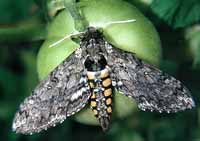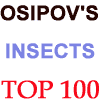|
|
Updated as per James P. Tuttle's The Hawk Moths of North America, July 2010
Updated as per Butterflies and Moths of North America, formerly USGS, July 2010
|
Clark County, Nevada
Sphingidae
This site has been created by Bill Oehlke.
Comments, suggestions and/or additional information/sightings with images are welcomed by Bill.
Eighteen Sphingidae species are listed for Nevada on the U.S.G.S.
website. Not all of the species are reported or anticipated in
Clark County.
(Thirteen species are reported on U.S.G.S. as of July 2010).
It is hoped
that this checklist, with the thumbnails and notes, will help you
quickly identify the moths you are likely to encounter.
A "WO" after the species name indicates that
I (William Oehlke) expect that this moth is present or
might be present, although unreported.
A "USGS" indicates the moth is confirmed
on USGS site.
Please help me develop this list with improved, documented accuracy
by sending sightings (species, date, location), preferably with an
electronic image, via email to
Bill Oehlke.
Visit Nevada Catocala: Underwing Moths.
Visit Clark County Sphingidae Larvae for Sphingidae larvae (caterpillars) expected in Nevada.
If you are travelling outside the state or country, visit Sphingidae of the Americas: pictoral checklists for all USA states,
all Canadian provinces, Mexico and all coutries in Central and South America.
Sphinginae subfamily
Sphingini tribe:
 |
This species has not been reported in your county, but may be
there as a very rare stray. The moth is a very
strong flier and is frequently encountered far north of its usual
range.
|
 |
This large bodied moth flies in tobacco fields and vegetable gardens
(potatoes, tomatoes) and wherever host plants are found. |
 |
Manduca sexta
USGS, the Carolina Sphinx.
Fw upperside has indistinct black, brown, and white markings.
Hw upperside is banded with black and white and has two black zigzag median lines that are very close together
with hardly any white showing between them.
Fw fringes are spotted with white.
|
 |
The upperside of the forewing is pale silver-gray with a series of
black dashes, a white patch at the tip, and a white stripe along the
outer margin. The upperside of the hindwing is black with blurry
white bands.
|
 |
Sphinx chersis
USGS, the Northern Ash
Sphinx or Great Ash Sphinx
The upperside of the forewing is soft dark-gray to blue-gray with
a series of black dashes, one reaching the wing tip. Note grey
thorax with narrow black lines.
|
 | Sphinx dollii (Wing span: 1 3/4 - 2 1/2 inches (4.5 - 6.3 cm)),
flies in arid brushlands and desert foothills from Nevada and
southern California east through Utah,
Arizona, Colorado, and New Mexico to Oklahoma and Texas.
|
 | The upperside of the forewing is pale blue-gray to dark gray with a black dash reaching the wing tip and
a white stripe along the lower outer margin.
The upperside of the hindwing is black with two diffuse white
bands, the upper one being practically non-existent.
|
 |
Sphinx perelegans
USGS, the Elegant Sphinx.
Sphinx perelegans adults fly in montane woodlands and mixed chaparral-type vegetation as a single brood
in the north, with adults mainly on the wing in June and July.
It flies from dusk until after midnight. Note dark thorax. |
 |
This species is reported in Clark County.
Adults fly as a single brood in the desert and in pinyon-juniper
woodland from May to August.
|
 |
Sphinx vashti
USGS, the Snowberry Sphinx
The upperside of the forewing has a narrow black subterminal line
bordered by a white inverted V-shaped line on the outside, and a
black line running inwards from the apex of the wing.
It is most often found in montane woodlands and along streamcourses.
|
Smerinthini Tribe:
 |
This one is quite similar to Pachysphinx modesta, with modesta
being smaller and darker.
Moths should be on the wing from June-August.
|
 |
Smerinthus cerisyi
USGS, the Cerisyi's
Sphinx or One-eyed Sphinx, Larvae feed on poplars and willows.
Flight would be from late May-July as a single brood.
|
 |
This small species is probably present in your county. This species ranges across North
America.
The hindwings have a small blue eyespot ringed with black on a yellow
background.
|
Macroglossinae subfamily
Dilophonotini Tribe:
 |
Erinnyis ello
USGS, stray, the Ello Sphinx
This species is reported most likely as a non-resident stray.
|
 |
Hemaris thetis USGS, the Thetis Clearwing or Bee Hawk Moth,
The moth flies along forest edges and in meadows, gardens and
brushy fields. Day-flying adults nectar at lantana, dwarf bush honeysuckle,
snowberry, orange hawkweed, thistles, lilac, Canada violet, etc.
|
Philampelini Tribe:
 |
Eumorpha achemon
USGS,
the Achemon Sphinx.
Adults nectar from flowers of Japanese honeysuckle
(Lonicera japonica), petunia (Petunia hybrida),
mock orange (Philadelphus coronarius), and phlox (Phlox).
Fight would be from June to August. Larvae feed on grape foliage. |
Macroglossini Tribe:
 |
Euproserpinus wiesti adults fly, during the day, over sand washes
and prairie
blow-outs as a single brood from May-June.
|
 |
Adults nectar at flowers during the warm parts of the day.
Euproserpinus phaeton adults fly swiftly and close to the ground over
dry washes and flat areas in deserts as a single brood from
February-April.
|
 |
Hyles lineata
USGS,
the White-lined Sphinx
Adults usually fly at dusk, during the night, at dawn, and during the
day. Moths nectar at a number of different flowers and oviposit on
Epilobium cana (California fuchsia) and
Hooker's Evening Primrose. |
 |
Proserpinus clarkiae
WO, Clark's Sphinx.
Adults fly in the afternoon from April-June in oak woodland and
pine-oak woodland in foothills, nectaring from chia, heartleaf
milkweed, golden currant, bluedicks, fairyfans, vetches,
thistles, hedgenettles, etc. |
|
|
Enjoy some of nature's wonderments, giant silk moth cocoons.
These cocoons are for sale winter and fall. Beautiful Saturniidae moths will emerge the following spring and summer.
Read Actias luna rearing article. Additional online help available.
Use your browser "Back" button to return to the previous page.
This page is brought to you by Bill Oehlke and the
WLSS. Pages are on space rented from Bizland. If you would like
to become a "Patron of the Sphingidae Site", contact Bill.
Please send sightings/images to Bill. I will do my best to respond to
requests for identification help.
 | 
Show appreciation for this site by clicking on flashing butterfly to the left.
The link will take you to a page with links to many insect sites. |
This website has been created and is maintained by Bill Oehlke without government or institutional financial assistance. All expenses, ie., text reference
support material, webspace rental from Bizland, computer repairs/replacements, backups systems, software for image adjustments (Adobe Photoshop; L-View),
ftp software, anti-virus protection, scanner, etc. are my own.
I very much appreciate all the many images that have been sent to me, or of which I have been granted permission to copy and post from other websites.
All images on this site remain the property of respective photographers.
If you would like to contribute to the maintenance of this website by sending a contribution to
Bill Oehlke
Box 476
155 Peardon Road
Montague, Prince Edward Island, C0A1R0
Canada
your donation would be much appreciated and would be used for
1) paying for webspace rental;
2) paying for computer maintenance and software upgrades;
3) purchases of additional text reference material (journals and books) in anticipation of expanding the site to a worldwide Sphingidae site;
4) helping to pay my daughter's tuition (completed spring 2013); with anything left over going to humanitarian aid.
If you are mailing a check from USA, please use $0.85 postage. ($1.15 is 2014 rate so check with post office as rates seem to be rising almost annually.)
Donations can also be made through Paypal via the button below.
